#london necropolis
Text
the London Necropolis
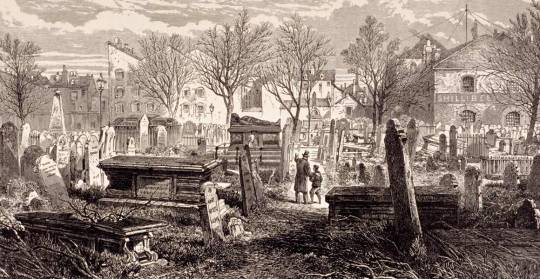
It was 1850 and London had a problem.
All right. London had a lot of problems in the 1850s. Thanks to the Industrial Revolution, London had seen its population boom so quickly that the city didn't have time to make room for everyone. Housing developments and slums sprang up seemingly overnight, cramming as many people into a warren of rooms, and partitioned off rooms. as could be fit. Poverty ran rampant, cholera outbreaks swept through districts regularly, the conditions in the factories, where small children were often also employed, were deadly and the environment itself was a lung-clogging morass of soot and sewage. Some made their fortunes and managed to rise through the layers of society but many simply hung on to the bottom rungs of it for as long as they could before their hands were wrenched off to make way for others. And that didn't just apply to the living.
The dead didn't know rest either.
It didn't take long for the graveyards of London to hit full capacity with the population influx. Even with the body snatchers, working to retrieve bodies for local hospitals and schools as well as even more unsavory employers almost as soon as the grieving family left the plot, couldn't keep up with the massive amount of bodies that needed to be buried in the local cemeteries week after week, month after month, year after year. The problem grew to the point that gravediggers, hitting older coffins would simply continue digging, tossing rotted wood and whatever body parts were left into the dirt pile behind them, making room for the newest arrival in the plot. Graves got so shallow that the bare layer of dirt over them easily washed away and utterly failed to keep what was slowly decaying in the boxes covered. Church goers learned to bring perfume covered handkerchiefs to Sunday services, if they were lucky, to hold over their noses the entire time, trying to blot out the smell seeping under the doors and into the confined interiors of the buildings. Flies and other, even more unpleasant, scavengers were impossible to get rid of, lured by the ease of a quick meal and a place to take up residence. Health inspectors, and many Londoners of the time, blamed the miasma rising from the graveyards for many of the disease outbreaks that swept through the city. Something had to be done.
An amendment was passed in 1852 prohibiting most new burials in the more populous sections of London. The problem was - where did you put the bodies then?
In 1832, the Magnificent Seven, seven large plots of land outside London, had been remade into cemeteries. One business group had higher aspirations than that though. In 1854, the Brookwood Cemetery, the largest cemetery of the time, opened for business. It soon became know by a different name.
The London Necropolis.
And the London Necropolis Railway was there to make sure everyone, dead and alive, found safe transportation there.
Railroads and their trains were still new at that time. Loud and noisy, belching steam and smoke into the air, trains weren't seen as a dignified way for the dead to travel to their final resting place and eternal peace. Worse yet, travel by train might lead to a mixing of the classes, dead as well as living (gasps of alarm and swooning!). Who wanted their sweet genteel maiden aunt's body to ride in the same cargo car as some low level rake's corpse?! Why it was undignified (and very against the social divisions of the time)! Even in death, standards must be applied.
Trains, however noisy and undignified, did offer a distinct advantage. They were cheap. And they ran regularly on a schedule you could plan around, daily in fact, including Sundays. As for social distinctions - well, the LNC had a solution for that too. Depending on the money you were willing to spend, the rail offered first, second, and third class funerals, with separate train cars for each class, living or dead. Knowing that most passengers from other stations would be reluctant to ride a train that had carried dead bodies, the LNC bought new cars and engines specifically for the job, kept separate from the other routes of train travel. They laid track specifically for the job as well, so that only the necropolis trains traveled to one of the two separate stations in Brookwood Cemetery. Mourners left the Waterloo Station in London and road the train, with their unique luggage, to either the Southern Anglican Station or the Northern Station, where the 'nonconformist' section of the burial plots were. While the trains originally only ran for funerals, enough mourners wanted to return for visits to the graves of their loved ones and eventually, after about ten years, the LNC built a third station for that purpose. Almost immediately, a small hub of shops and services sprang up around the new station to cater to, and prey on, the arriving mourners. For fifty years, until 1900, the funeral trains ran on schedule, ferrying bodies, and their loved ones, back and forth between London and the Necropolis. Even after that time, the trains still ran 'as needed' until, finally, in 1941 the London Necropolis station was bombed during the London Blitz. It was the final blow to an already declining system. The station was never rebuilt.
By the 1950s, funeral trains were almost obsolete and the last one in England carried its lonely cargo in 1979. By 1988, the British Railway didn't carry coffins anymore. Time, and more efficient methods, had passed the Necropolis funeral trains by. The tracks overgrew with weeds where they weren't torn up for scrap and the only wistful train whistle left to linger in the chill evening air at the grey and abandoned gates was the long, low ghost of a memory.

#superstition#london necropolis#london necropolis railway#funeral train#LNC#brookwood cemetery#train#trains#funeral#funeral rites#history#victorian#victorian era
53 notes
·
View notes
Text

coffin tickets to the London Necropolis
4 notes
·
View notes
Text
new Dead Boy Detectives headcanon: this is the building where the boys have their office and nobody can tell me different now (it's even near Westminster Bridge, where Charles and Crystal take their walk)
also obviously the Necropolis Railway is still active for ghostly users so Charles and Edwin can hear the trains rattling while they're working (they figure it's a small price to pay for the excellent location) and sometimes they take the lift down and hitch a ride to Woking when they feel like a holiday. They and the other tenants are engaged in an ongoing haunting campaign to ensure the building never gets sold
42 notes
·
View notes
Note
Vampires crawling out of that thang...
literally. mina batting them all back like whack-a-mole
4 notes
·
View notes
Text

5 notes
·
View notes
Text

5 notes
·
View notes
Text



Victims of the past.
Brompton Cemetery
London, UK
#cemetery#graveyard#necropolis#churchyard#melancholy#darkness#dark#dark beauty#dark aesthetic#aesthetic#gothic#gothic beauty#gothic aesthetic#sculptures#bnw#brompton cemetery#london#uk#oddities and curiosities#travelling strangers
1 note
·
View note
Text
i havent seen her inbox since the past two years
a new message
"ive been obsessed with this song lately"
so have i
0 notes
Photo
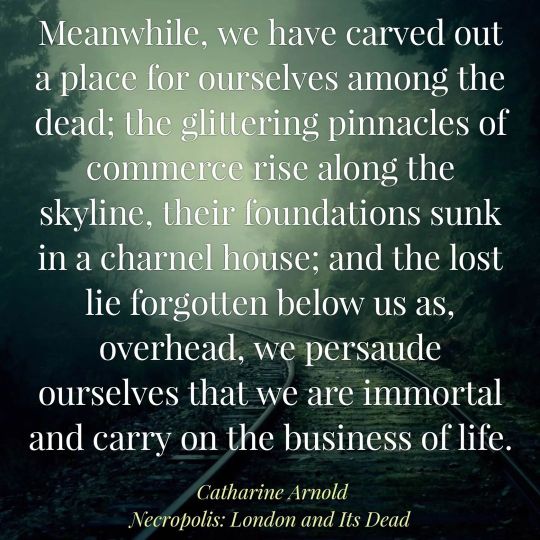
QUOTE OF THE DAY
Monday, November 21, 2022
"Meanwhile, we have carved out a place for ourselves among the dead; the glittering pinnacles of commerce rise along the skyline, their foundations sunk in a charnel house; and the lost lie forgotten below us as, overhead, we persaude ourselves that we are immortal and carry on the business of life."
- Catharine Arnold, Necropolis: London and Its Dead
~~~~~~~~~~~~~~~~~~~~~~~~~~~~~~~~~~~~~~~~~~~~~~~~
Quote choice inspired by The Free Dictionary's Word of the Day: necropolis.
Interested in the book? Snag it real quick by clicking here!
Image made with the Quotes Creator App.
See the original post on Instagram!
Watch MonriaTitans on Twitch and YouTube!
#catharinearnold#necropolislondonanditsdead#quoteoftheday#educational#necropolis#businessoflife#carryon#cemeteries#commerce#dead#death#forgotten#immortal#london#tfd#wordoftheday#wotd#thefreedictionary#educationalpost#educationalposts#learnsomethingneweveryday#becomesmartereveryday#becomempowered#bempowering#monriatitans#theweekendgameshow#wgs#quotescreatorapp#affiliatelink#amazon
0 notes
Photo

The London Necropolis Railway, Westminster Bridge Road Entrance.
602 notes
·
View notes
Text
Terzo Emeritus: Turin.
Primo | Secondo | Terzo.

We know Terzo spent some time as a Cardinal in Poland (I'm going to do some research on Krakow too, just for fun), but if I had to locate him somewhere in Italy, I know where to place him. For Terzo, the most mystical and mysterious of the Papas, I have thought of the most evil and contrasting city in Italy: Turin.
Turin is, literally, the Italian City of the Devil, and it is divided into two sides, one evil (black) and one good (white). Let's see what may have influenced the rebellious Terzo Emeritus.
This will be a long one.
1 - Life and death, good and evil, black and white…

Turin is geographically divided into two sides: the good side to the east, where the sun rises, and the evil side to the west, where the sun sets, divided by the gates of the Royal Palace. Both sides feature monuments and buildings reflecting their predominant energy, and each side counterbalances the magical influence of the other. Turin, with its duality, is both a point of the Black Magic triangle (Turin, London, San Francisco) and one of the White Magic triangle (Turin, Lyon, and Prague).
On the west side, the dark one, the ancient Romans had built the necropolis and the gallows where condemned prisoners were executed. There was nothing but death and darkness.
On the east side, the bright one, the Mole Antonelliana acts as an antenna that gathers white energy from the ground and projects it onto the city through its tip. (Additionally, there is the Sacra Sindone, the cloth with the image of Jesus supposedly printed with his sweat and blood.)
The combination of the two forces creates a coniunctio oppositorum.
Given that Meliora is based on the concept of a city overpowered by dark forces, I believe a whole city where contrasting forces are so strong that they have shaped its aesthetic would have been fitting for him.
2 - Mysterious spectre wrestles power supplies from oligarchs.

The negative fame of Turin seems to stem from the hard rivalry between the Savoy family and the Vatican, especially during the Risorgimento, when Turin was labeled as "diabolical" due to its strongly anti-clerical positions. Turin (and Savoy family) became the anti-Vatican, basically, and we know how controversial Terzo was considered in the Ministry.
So the Savoy family erected five buildings in five different points of the city to form a pentacle: the hunting reserve of Stupinigi, the Moncalieri Castle, the Rivoli Castle, the Venaria Reggia, and the Basilica of Superga. (I have tried tracing the pentacle lines myself, as you can see in the image. Yep, that’s true.) Additionally, the cremation practice was strongly pushed by Turin, in opposition to the traditional burial.
And you are here to stay and burn with me, right?
3 - Lucifer’s statue.

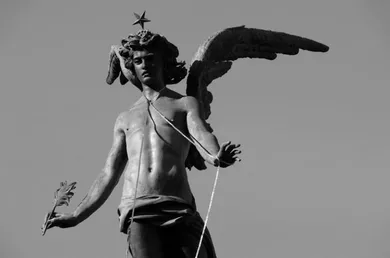
Piazza dello Statuto coincides with the apex of the black magic triangle and the place where prisoners were executed, and it is right here that the presumed statue of Lucifer stands, above a necropolis that is called both la Vallis Occidanum, “West valley” or "where the sun sets" and Vallis Occisorum "Valley of the murdered". The statue is actually a fountain, built in memory of the victims of the Frejus tunnel accident... but looking at it, it's easy to understand that there is something more. The angel placed on the top of the fountain bears an upside-down five-pointed star on its head, and its gaze is not directed towards the Frejus, as one would expect, but towards the white part of the city. Towards the light.
I don’t know you, but to me, He is.
4 - The Masonic headquarters.
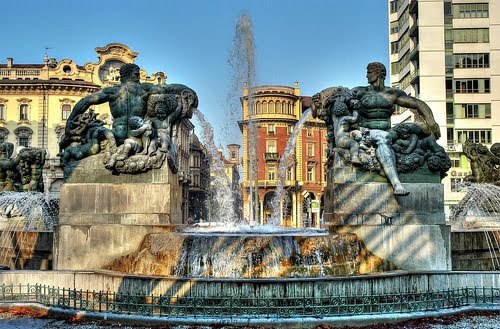
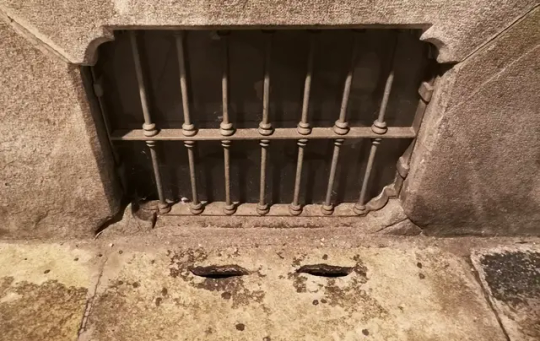
Terzo was known to have included many references to the Freemasons, especially in Square Hammer, where many see in the lyrics the tale of a Freemasonry initiation ritual.
In Piazza Solferino, we find the Fountain of the Four Seasons, where the four seasons are represented by four statues: spring and summer by two female figures, while autumn and winter by two male figures. Those male figures are identified with the giants Boaz and Joaquin, supporters of the pillars of Hercules which, in Masonic symbolism, would represent the first step of the initiate in their Masonic journey. Furthermore, it is said that the water of that fountain it’s a source of knowledge.
Continuing on the Masonic path, on via Lascaris, there is now a bank, but in the past, it was the headquarters of a Masonic lodge (curious that in a former Masonic lodge, there is now a bank... Mummy Dust-curious). On the sidewalks of the street, you can notice cracks in the shape of evil eyes. The gaze of the devil.
5 - The first lightning rod in Italy.

Terzo is often depicted surrounded by lightning, so he must have felt at home in Turin. In 1752, in fact, Gianni Battista Beccaria successfully repeated Benjamin Franklin's experiment by installing a lightning rod above his apartment. He created the first lightning rod ever seen in Italy, but since then Beccaria was accused of wizardry for his ability in manipulating electrical energy.
I know that I set a maximum of 5 points, but Turin is so full of occultism that I had to add a bonus point. 👇🏻
6 - the Devil’s door.
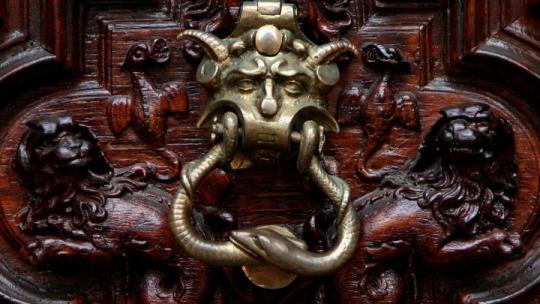
This door could have a post on its own for how much there is to say about it, but I’ll cut it short.
Legend has it that it was built in one night by the devil himself to punish a man who had invoked him in vain, and since its installation, terrifying episodes have occurred inside the building, such as the disappearance of a soldier or the murder of a dancer stabbed during a dance that lasted three days and three nights.
The decorations on the door are rich in esoteric symbolism (There is also a little rat…) and in the center, the clapper is literally the face of the devil with two snakes, while in the central column there is a monster holding the world in its claws.
Today, this building also houses a bank… my Mummy Dust.
#the band ghost#papa emeritus lll#ghost band#ghost headcanons#italian cities#terzo emeritus#ghost theories#papa terzo
68 notes
·
View notes
Text

Female Europid Mummy from the Necropolis of Subexi III, Grave M6, Turfan District, Xinjiang. 5th-3rd C. BCE. Source: Baumer, Christoph.The history of Central Asia. Vol.1. The age of the steppe warriors. London : I.B. Tauris, 2012. pg. 218 left DS329.4 .B38 2012. Image via University of Pennsylvania. See maps in the post before this one for a better understanding of the geography discussed.
"Section 26 – The Kingdom of Nearer [i.e. Southern] Jushi 車師前 (Turfan)
1. ‘Nearer Jushi’ 車師前 refers to the kingdom or state centered in the Turfan oasis or, sometimes, to the tribe which controlled it. There can be no question that Nearer Jushi refers here to the Turfan Oasis. See for example: CICA, p. 183, n. 618; also note 1.5 above. For the etymology of the name Turfan see Bailey (1985), pp. 99-100, which is summed up in his sentence: “The name turpana- is then from *druva-pāna- ‘having safe protection’, a name suitable for a walled place.”
“One other oasis town is currently under excavation. At Yarghul (Jiaohe), 10 km (16 miles) [sic – this should read 10 miles (16 km)] west of Turpan, archaeologists have been excavating remains of the old Jushi capital, a long (1,700 m (5,580 ft)) but narrow (200 m (656 ft)) town between two rivers. From the Han period they uncovered vast collective shaft tombs (one was nearly 10 m (33 ft) deep). The bodies had apparently already been removed from these tombs but accompanying them were other pits containing form one to four horse sacrifices, with tens of horses for each of the larger burials.” Mallory and Mair (2000), pp. 165 and 167.
“Some 300 km (186 miles) to the west of Qumul [Hami] lie [mummy] sites in the vicinity of the Turpan oasis that have been assigned to the Ayding Lake (Aidinghu) culture. The lake itself occupies the lowest point in the Turpan region (at 156 m (512 ft) below sea level it is the lowest spot on earth after the Dead Sea). According to accounts of the historical period, this was later the territory of the Gushi, a people who ‘lived in tents, followed the grasses and waters, and had considerable knowledge of agriculture. They owned cattle, horses, camels, sheep and goats. They were proficient with bows and arrows.’ They were also noted for harassing travellers moving northwards along the Silk Road from Krorän, and the territories of the Gushi and the kingdom of Krorän were linked in the account of Zhang Qian, presumably because both were under the control of the Xiongnu. In the years around 60 BC, Gushi fell to the Chinese and was subsequently known as Jushi (a different transcription of the same name).” Mallory and Mair (2000), pp. 143-144.
“History records that in 108 BC Turpan was inhabited by farmers and traders of Indo-European stock who spoke a language belonging to the Tokharian group, an extinct Indo-Persian language [actually more closely related to Celtic languages]. Whoever occupied the oasis commanded the northern trade route and the rich caravans that passed through annually. During the Han Dynasty (206 BC-AD 220) control over the route see-sawed between Xiongnu and Han. Until the fifth century, the capital of this kingdom was Jiaohe.” Bonavia (1988), p. 131.
“Turpan is principally an agricultural oasis, famed for its grape products – seedless white raisins (which are exported internationally) and wines (mostly sweet). It is some 80 metres (260 feet) below sea level, and nearby Aiding Lake, at 154 metres (505 feet) below sea level, is the lowest continental point in the world.” Ibid. p. 137.
“The toponym Turfan is also a variation of Tuharan. Along the routes of Eurasia there are many other place names recorded in various Chinese forms that are actually variations of Tuharan.” Liu (2001), p. 268."
-Notes to The Western Regions according to the Hou Hanshu. Second Edition (Extensively Revised and Expanded). John E. Hill. University of Washington.
#tocharian#celtic#indo european#tarim basin#xinjiang#chinese history#mummies#history#ancient history#archaeology#anthropology#silk road#pagan
462 notes
·
View notes
Note
I nearly forgot! For the DBDA ask game, 4 and 20? <33
4. Something you wanted to see in season 2?
I would have loved to see them do cases in London! all due respect to weird small-town America but I wanted to see the boys on their home ground, which happens to be one of the most chaotically magical cities out there. Let them take the Necropolis Railway and try to exorcise the M25 and go to the pub with Johanna Constantine.
20. Which character's style do you like the best?
I've answered this briefly elsewhere, but I will expand on it further: The Night Nurse, because I am a huge sucker for the 1940s aesthetic. I am also obsessed with why the whole Lost & Found department has this aesthetic, actually. On the Doylist hand, a lot of media cleaves to the mid-century vintage aesthetic for ineffable bureaucracies (see everything from The Umbrella Academy to John Wick); on the Watsonian, however, perhaps the Lost & Found has never really moved past World War II, that it's the reason for "you see how backed up things are around here?" (to quote the Notary), that even eighty years on their workflow hasn't fully recovered and so they all still look like they're stuck in the 1940s.

(from the DBDA ask game, thanks for asking!)
#procrasktination#dead boy detectives#save dead boy detectives#renew dead boy detectives#the night nurse
27 notes
·
View notes
Text
reading about the london necropolis railway again :-)
233 notes
·
View notes
Text

London went into state of rapid expansion during the 19th century - both in geographical terms and in the growth of its population. These two factors resulted in one unfortunate problem; the city began to run out of burial sites. The previous space-saving idea of 'stacking' unrelated deceased people on top of each other and reducing the amount of earth covering graves failed. (Heavy rain led to exposed caskets and corpses). London belonged to the living and so plans were made for large cemeteries to be built outside the city borders. Transportation of the dead to these graveyards would come courtesy of The London Necropolis Railway.

The service ran from 1854 to 1941. Mourners were provided with carriages and ferried to graveyards far from where their loved ones had lived.

As in all UK history, class played its part. The upper classes - living and dead - were given private carriages. This was mirrored in the cemeteries, where the poor were interred away from the lawns and flowerbeds of the rich.

The former London Necropolis Railway station building as it is today.
3 notes
·
View notes
Text
But There is No Road Through the Woods
An elderly forester, cursed with immortality, accepts the arduous task of guiding an eclectic troupe of travellers through the Lost Forest; a wilderness claimed by spirits, fae, and the undead. But as he struggles to keep his charges alive, he finds himself being reminded of his humanity and his long-buried desire to find something worth living – or dying – for.
The Lightning Herders
Barely a day after their move, a young family’s farm in rural Canada is trapped in a dangerous and never-ending thunderstorm. Determined to stop it, Third – an autistic aspiring inventor – sets out on a quest to uncover the many mysteries of her new home. Why is their landlord’s room glowing green and why does he have a chained chest under his bed? What does the destroyed angel monument have to do with anything? Is the forest truly full of ghosts?
But when another young girl falls out of the sky in an inexplicable flying machine, Third’s world suddenly gets a lot bigger. There is an entire domain of danger and magic above the clouds… and it’s all connected back to Third’s new home.
The London Necropolis Railway
A medium who spends his days secretly reassuring the departed on the Victorian railway to the graveyards beyond the city reunites with a childhood friend only to learn a feared necromancer has infiltrated the train and is putting deadly wheels into motion. Now it’s up to a man who jumps at his own shadow to hold his own amongst the living dead.
135 notes
·
View notes